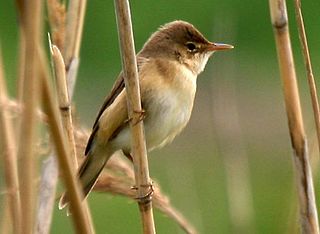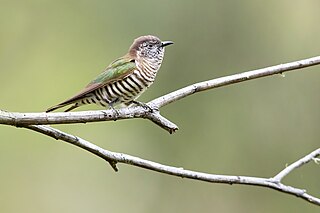
The common redstart, or often simply redstart, is a small passerine bird in the genus Phoenicurus. Like its relatives, it was formerly classed as a member of the thrush family, (Turdidae), but is now known to be an Old World flycatcher.

The spotted flycatcher is a small passerine bird in the Old World flycatcher family. It breeds in most of Europe and in the Palearctic to Siberia, and is migratory, wintering in Africa and south western Asia. It is declining in parts of its range.

The tree pipit is a small passerine bird which breeds across most of Europe and the Palearctic as far East as the East Siberian Mountains. It is a long-distance migrant moving in winter to Africa and southern Asia. The scientific name is from Latin: anthus is the name for a small bird of grasslands, and the specific trivialis means "common".

The common reed warbler is an Old World warbler in the genus Acrocephalus. It breeds across Europe into the temperate western Palaearctic where it is migratory, wintering in sub-Saharan Africa. It is also a resident species over large parts of Africa.

The Guinea turaco, also known as the green turaco or green lourie, is a species of turaco, a group of African otidimorph birds. It formerly included the Livingstone's, Schalow's, Knysna, black-billed and Fischer's turacos as subspecies.

The green wood hoopoe is a large, up to 44 cm (17 in) long tropical bird native to Africa. It is a member of the family Phoeniculidae, the wood hoopoes, and was formerly known as the red-billed wood hoopoe.

The Jacobin cuckoo, also pied cuckoo or pied crested cuckoo, is a member of the cuckoo order of birds that is found in Africa and Asia. It is partially migratory and in India, it has been considered a harbinger of the monsoon rains due to the timing of its arrival. It has been associated with a bird in Indian mythology and poetry, known as the chātaka represented as a bird with a beak on its head that waits for rains to quench its thirst.

The Indian cuckoo or short-winged cuckoo is a member of the cuckoo order of birds, the Cuculiformes, that is found in the Indian subcontinent and Southeast Asia. It ranges from India, Bangladesh, Bhutan, Nepal and Sri Lanka east to Indonesia and north to China and Russia. It is a solitary and shy bird, found in forests and open woodland at up to 3,600 m (11,800 ft).

The yellow-rumped thornbill is a species of passerine bird from the genus Acanthiza. The genus was once placed in the family Pardalotidae but that family was split and it is now in the family Acanthizidae. There are four subspecies of yellow-rumped thornbill. It is a small, brownish bird with a distinctive yellow rump and thin dark bill. It inhabits savannah, scrub and forests across most of Australia and eats insects. The species engages in cooperative breeding.

Cuculus saturatus, better well known as the Himalayan cuckoo or Oriental cuckoo, is a brooding parasitic bird that is part of the Cuculidae family. The species breeds from the Himalayas eastward to southern China and Taiwan. It migrates to southeast Asia and the Greater Sunda Islands for the winter.

The mangrove cuckoo is a species of cuckoo that is native to the Neotropics.

Cuculus is a genus of cuckoos which has representatives in most of the Old World, although the greatest diversity is in tropical southern and southeastern Asia.

The tropical boubou or bell shrike is a medium-sized passerine bird of sub-Saharan Africa. This very diverse "species" with its numerous subspecies and morphs has since long posed a taxonomic problem, and recent research suggests it is a cryptic species complex that has now been split into several species.

The shining bronze cuckoo is a species of cuckoo in the family Cuculidae, found in Australia, Indonesia, New Caledonia, New Zealand, Papua New Guinea, Solomon Islands, and Vanuatu. It was formerly placed in the genus Chrysococcyx.

The little bronze cuckoo is a species of cuckoo in the family Cuculidae. It was formerly placed in the genus Chrysococcyx. It is a common brood parasite of birds form the genus Geryone. This cuckoo is found in Southeast Asia, New Guinea and some parts of Australia, where its natural habitat is subtropical or tropical moist lowland forest. It is the world's smallest cuckoo. The pied bronze cuckoo was formerly considered to be a subspecies. Other common names for the little bronze cuckoo include the red-eyed bronze cuckoo and the malay green cuckoo. It has 11 subspecies which are generally recognized.

The African cuckoo or African grey cuckoo is a species of cuckoo in the family Cuculidae. It is found in Sub-Saharan Africa where it migrates within the continent, generally arriving and breeding in any one locality during the rainy season. A fairly common bird, the International Union for Conservation of Nature has rated its conservation status as being of "least concern".

The red-chested cuckoo(or Nyamuthowathowane in the Luvenḓa language), is a species of cuckoo in the family Cuculidae. It is a medium-sized bird found in Africa, south of the Sahara. In Afrikaans, it is known as "Piet-my-vrou", after its call.

The black-backed puffback is a species of passerine bird in the family Malaconotidae. They are common to fairly common sedentary bushshrikes in various wooded habitats in Africa south of the equator. They restlessly move about singly, in pairs or family groups, and generally frequent tree canopies. Like others of its genus, the males puff out the loose rump and lower back feathers in display, to assume a remarkable ball-like appearance. They draw attention to themselves by their varied repertoire of whistling, clicking and rasping sounds. Their specific name cubla, originated with Francois Levaillant, who derived it from a native southern African name, where the "c" is an onomatopoeic click sound. None of the other five puffback species occur in southern Africa.

The Oriental cuckoo or Horsfields cuckoo is a bird belonging to the genus Cuculus in the cuckoo family Cuculidae. It was formerly classified as a subspecies of the Himalayan cuckoo, with the name 'Oriental cuckoo' used for the combined species. Differences in voice and size suggest that it should be treated as a separate species. The binomial name Cuculus horsfieldi has often been used instead of Cuculus optatus, but is now usually considered to be a junior synonym.

The fork-tailed drongo-cuckoo is a species of cuckoo that resembles the Black drongo. It is found mainly in hill forests in peninsular India and Sri Lanka although some specimens are known from the Himalayan foothills. It can be identified by its metallic black plumage, straight beak, white barred vent, forked tail and white spot on the back of the head. The fork-tailed drongo-cuckoo's song has been described as a series of 5 or 6 whistling "pip-pip-pip-pip-pip-" notes rising in pitch with each "pip". They are also known for their drongo-like calls such as "quip" calls in flight and "wheep-wheep" call with a higher second note. In Sri Lanka, the fork-tailed drongo-cuckoo also has similar calls to the Sri Lanka Drongo.





















